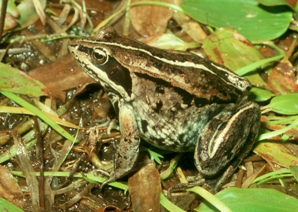Wood frogs spend the winter on land and can survive freezing conditions--even when their blood and other body fluids freeze. When warmer weather returns in the spring, they simply thaw out and resume their normal activities.
Photo Credit: Geoffrey A. Hammerson
Lithobates sylvaticus
Common Name: wood frog
Other Scientific Names: Rana sylvatica
Animal Guild: Amphibian
Class > Order > Family: Amphibia > Anura > Ranidae
What does the species look like?
Adults: Wood frogs have a dark "mask" across each eye, prominent raised ridges along the sides of their back, and relatively smooth skin. Their hind toes are webbed. Adults may or may not have a light stripe down their back. They can reach a length of about 3.3 inches (83 mm).
Mature males: The base of their thumbs is swollen. Adult males tend to be slightly smaller and darker than adult females.
Breeding call: The call is a rapid series of one to eight (usually three to five) rough, clacking notes. A chorus sounds somewhat like a group of softly quacking domestic ducks.
Larvae: Tadpoles have blackish and olive-gray backs, and their sides are shiny bronze or pinkish. Their tail fin is high, arched on top, and has dark spots and blotches. They generally can reach a total length of around 2 inches (52 mm).
Eggs: Eggs are black above, whitish below, about 0.1 inches (2 mm) in diameter. Each egg is surrounded by two jelly envelopes. Eggs are usually laid communally in large round masses about the size of a baseball or tennis ball and usually contain several hundred eggs.
Where is the species found?
States & Provinces
AB, AK, AL, AR, BC, CO, CT, DC, DE, GA, ID, IL, IN, KY, MA, MB, MD, ME, MI, MN, MO, NB, NC, ND, NH, NJ, NL, NS, NT, NU, NY, OH, OK, ON, PA, PE, QC, RI, SC, SD, SK, TN, VA, VT, WI, WV, WY, YT
Distribution
The range extends from northern Alaska across boreal Canada to Labrador and south to New Jersey, northern Georgia, and northern Idaho; with a spotty distribution south to northern Colorado in the Rocky Mountains; and disjunct populations in Arkansas-Missouri. The range extends farther north than that of any other North American amphibian.
They can be found in wooded areas.
General Phenology and Life History
Wood frogs spend winter on land, emerge in later winter or spring, and travel up to several hundred yards (several hundred meters) to water to breed. They breed explosively (over a short period of time) in vernal pools or other fish-free temporary bodies of water. Within a few months after the eggs are laid, larvae metamorphose into small frogs in spring or summer.
Which phenophases should I observe?
Do you see/hear...?
Activity
Adults on land More...
For abundance, enter the number of individual animals observed in this phenophase.
Adults in water More...
For abundance, enter the number of individual animals observed in this phenophase.
Adults feeding For abundance, enter the number of individual animals observed in this phenophase.
Reproduction
Vocalizing What is the intensity of vocalizing?
Single calls: There is space between calls and individuals can be counted. Overlapping calls: Calls of individuals can be distinguished but there is some overlapping of calls. Full chorus: Calls are constant and overlapping.
Mating For abundance, enter the number of individual animals observed in this phenophase.
Fresh eggs For abundance, enter the number of individual animals observed in this phenophase.
Development
Dead adults For abundance, enter the number of individual animals observed in this phenophase.
What do these phenophases look like?
There is currently no photoguide available for this species. If you'd like help us create one, use the guidance document and species template provided here . Then send it via email to education@usanpn.org when it is complete.
